A conversation with Peter Tepe | Section: Interviews
Abstract: The artist Detlev van Ravenswaay defines the terms space art and astronomical art. His motto: creative, artistic ideas on complicated scientific contexts promote the motivation to explore the universe. He shows the influence of celestial phenomena in two cases of cultural history, as a result the Nebra sky disk and Turner’s impressionism. The second half traces the artist’s career as a child of the space age, as a meticulous documentary in his youth, as a creative visionary at work, and as a sympathetic contemporary, valued on Earth and in outer space.
Detlev van Ravenswaay, your artistic career can be subdivided into two major phases: the phase of Space Art (from 1979 until today) and the phase of free art (which has started in 2012). In our today’s talk, we will exclusively deal with the first phase.
Thank you very much for giving me the opportunity to speak about Space Art on the internet, a medium that actually owes its invention to space exploration.
Not all the users of the online journal will be familiar with Space Art. This is why I would like to ask you first of all to explain what is meant by this term.
The terms Space Art or Astronomical Art (I prefer the latter) are used for pictorial representations of aspects of the cosmos or the universe. Obviously, Astronomical Art also allows to represent utopias, but always on the basis of the current state of research in natural science. “Beam me up, Scotty” remains Science Fiction.
It has to do with science and cultural history, with technology and last but not least with Man, who has always felt the urge to leave planet Earth and to explore the universe.
Detlev van Ravenswaay has been producing Astronomical Art since 1979.
A representative of Space Art / Astronomical Art is therefore an artist whose work can be called – in the terminology of the online journal – scientifically oriented: he refers to theories and/or methods and/or research results of certain scientific disciplines. Which sciences are we talking about?
Astronomical Art is based on the research results in astronomy and physics as well as on the prevailing state of development of aerospace technology. This is why Space Art usually tends to reflect the state of scientific-technical knowledge as it was at the time of its creation.
Chemistry and medicine have brought up the question how life came on our planet and which chemical conditions must be given for life to emerge. Astronomical Art can deal with this kind of issues, too.
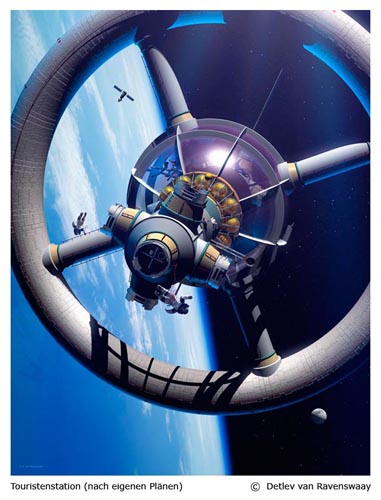
Does this space art also have a retroactive impact on the scientists that are exploring space?
This happens from time to time indeed: Space Art can increase the motivation of astronauts, space explorers and technicians – I can confirm this from my own personal experience. Sometimes, it continues to have an effect on several generations, as for instance the work of Chesley Bonestell, who painted for the TIME magazine and whose illustrations have been admired and quoted by numerous scientists, engineers and science writers for more than seven decades. Even today, his visualizations of Wernher von Braun’s ideas are considered an exemplary collaboration between two visionaries.
It is rather easy to imagine that a space artist is able to create convincing visualizations of the ideas of space explorers and technicians. Beyond this, are there any cases in which a space artist inspires space scientists to develop new creative scientific ideas and thus contributes to a reconfiguration of that particular science?
20 years ago, astronomer Michel Major discovered the first exoplanet, that is a planet that orbits another star of our galaxy. But already decades before Astronomical Artists had painted sceneries of such planetary systems. They had also shown exoplanets moving across the “star disc”. Thus, certain Astronomical Art pictures could stimulate space researchers to search for exoplanets.
Detlev van Ravenswaay’s work contains portraits of famous scientists.
Listening to your explanations of Space Art, a historical question arises in my mind. If Space Art/Astronomical Art is defined as the pictorial representation of aspects of the universe, would we not then have to pretend that an early man carving stars into a rock face or drawing the crescent moon into the sand is actually producing Space Art?
Indeed I am convinced that one should search for the origins of Space Art in very early stages of the history of mankind. 3600 years ago, for instance, our planet was hit by a catastrophe that is familiar to volcanologists and archaeologists: the explosion of the Santorin island.
To my mind, this event globally changed the sky for months. My research and my astronomical experience led me to the concluding diagnosis that there were nights then, in which only a few stars could be seen even though the sky was cloudless. There was a goldish or orange moon, heavy rainfalls and colorful, bright rainbows, extreme morning and evening glow. The sky seemed to burn and bleed. Polytheistic men will have attributed this phenomenon to an annoyance of the gods. This is where I start to theorize: It was reason enough for the nature-bound creative people to create a disk that was then, during worship and prayer, held up against the sky – the Nebra sky disk, which I consider an excellent example of Astronomical Art.
How do modern natural sciences explain the mentioned phenomena?
The volcanic eruption of Krakatoa in 1883 brought one cubic kilometer of volcanic ash into the atmosphere, Santorin – 3600 years ago – ten times this amount. This is well known. Meteorologists have confirmed the atmospheric consequences of volcanic dust. After volcanic eruptions, astronomers have to interrupt their observations, travelers must face flight cancellations because the engines could fail. Even today, red sunsets after volcanic eruptions are a common phenomenon. Adding up all these facts as an Astronomical Artist, creating something like the Nebra sky disk just seems to be a logical consequence.
Are there any artworks from the more recent centuries that you would classify as belonging to Astronomical Art?
I will restrict myself to one example. In the years 1815/16, sunrises and sunsets worldwide turned red because of the volcanic dust from the erupted volcano Tambora in Indonesia. The British painter William Turner integrated this red sky color into his impressionist paintings. In these particular works one could consider Turner a Space Artist because he documented the atmospheric appearance of planet Earth.
Can you give us an example to illustrate how the results of space research influence Space Art?
Before the landing of the two VIKING space probes on Mars’ surface in the year 1976, Space Artists used to represent the sky of Mars in different shades of blue; after the landing, though, only in delicate variations of ochre. The proportion of dust in the light atmosphere of Mars was higher than the scientists had expected, the atmospheric gases much more reduced. Space Artists immediately included the now revealed real conditions into their illustrations of Mars. After 1976, contemporary Space Art works of Mars never again showed a blue sky at high solar incidence. This is a wonderful example for how Astronomical Art usually proceeds.
The exploration of other planets is a popular theme in Astronomical Art.
Nowadays Space Artists often deal with new astronomical theories and the scientific findings that these theories engender, or with future projects such as the colonization of planets. They basically produce illustrations of these concepts, which obviously turn out to be very different, according to the motivation or qualification of the prevailing artist – most of us are working independently.
Depictions of the Big Bang.
Can you name some more main representatives of Space Art and tell our users where to get closer information on this movement?
In France, Lucien Rudaux is recognized as the first scientifically oriented Space Artist to have represented Mars and the moon in a realistic manner. His book Sur les Autres Mondes, issued in 1937, continues to impress readers even today. In the USSR, artist Andrey Sokolov collaborated with cosmonaut and Space Artist Alexey Leonov on paintings proclaiming the glory of the Soviet spaceflight successes and on plans for the exploration of the solar system. In the USSR, many of Leonov’s paintings were used as printing templates for special postage stamps and postcards. He was the first human to leave his spacecraft for a spacewalk in the Earth orbit.
In England there is David Hardy artistically conquering the universe since the 1960s, for about ten years he is accompanied by the Briton Dr. Marc Garlick. In Czechoslovakia, Ludek Pesek painted scenes on other planets in a winningly photorealistic manner. In the USA, we have had artists like Robert McCall and Paul Calle, and have Ron Miller, Don Dixon and Don Davis. In Japan, Shigemi Numazawa is working on astronomical artworks.
By the way, Space Artists have organized in the IAAA, the International Association of Astronomical Artists, a club of Space Artists that meet once a year for workshops at geologically interesting locations.
Publications can be found on the internet or in libraries under the name of the mentioned artists.
We are not only talking about Space Art in general, but also about Space Artist Detlev van Ravenswaay. Let’s begin with what has happened so far.
I was born right on time, directly into the era of space exploration. In 1957, the first Sputnik was launched into Earth orbit. In 1961, our neighbor shouted out of the window: “A human is flying through space!”

I suppose a Space Artist to have been fascinated by space exploration since early childhood. Is this your case, too?
At the age of nine, I happened to find a children’s magazine with a report on the Gemini 5 mission. A high orbit offered a view of the strongly curved Earth horizon so that the spherical shape of our home planet became visible. For me, this was a kind of key experience – I was triggered and fascinated. It got me once for all at Christmas 1968, when the three astronauts onboard of the Apollo 8 spacecraft were the first humans to really fly into space, leaving the gravitational field of the Earth on their way to the moon.
I started constructing realistic models of wood and paper, models that weren’t available as plastic construction kits.
Soviet illustrations from the 1970s, as those of Salyut 1 space station, Luna 16 lander or the moon rover Lunokhod 1, appealed to me and told me: “You can do this as well! You want to do this as well!” So my motivation was quite high right from the beginning. I quickly became an expert in space exploration history. My teacher commented on this as follows: “One day our Detlev will fly into space.”
The crew emblem of Apollo 15, which had been designed by an Italian fashion designer, gave rise to the desire to design an emblem for astronauts myself. Only 12 years later, in June 1983, this dream became true. The team members of the first German Spacelab mission asked me to create a Science Astronaut emblem. The following year, I had my own office just next to the offices of the German Spacelab astronauts. This was a great confirmation of my creative work.
So, we can state that in your childhood and in your youth, you were mainly fascinated by space exploration. Later, though, you got engaged in those sciences which aerospace technology is based on. Which sciences are these, and how deep did you get into them?
I studied electro-technical engineering for 4 years. In the early 1970s – that is in the early beginnings of computer technology – I worked as a programmer. However, this didn’t give me the creative fulfillment that I expected from working life. Only graduating as a designer led to the satisfaction of my personal desires – and to success. I found my vocation in life.
On May 21st 1983, when I was studying photography with Prof. Detlef Orlopp in Krefeld, my first portrait series, which immortalized Prof. Hermann Oberth, the Father of German Rocketry, in his own museum in Feucht, came into being. On the very same day, I observed the approaching NASA-747 carrying Space Shuttle Enterprise during its landing at Cologne Airport. This experience continues to have an effect on me, even now.
I then got illustration jobs from German astronauts, which made it possible for me to work independently for the astronaut office. This is where I was commissioned to coordinate the documentation of the research projects of the Spacelab Mission D1. More than 80 research teams from different faculties – medicine, biology, material sciences and other disciplines carried out experiments on board. My task was to sum up the experiment descriptions and to create a documentation that was then published in book form.
The artist maintains close contacts with scientists who happen to commission him to create mission emblems.
In 2005, the European Space Agency (ESA) asked me to create the mission emblem ASTROLAB for the astronaut Thomas Reiter on his 180 days flight to the International Space Station (ISS).
The disciplines that are important for my Space Art works are: physics, astronomy, planetology and the engineering sciences, such as for example astronautics, which deal with the development of technologies that could make life on other planets (currently on Mars) a possibility. Certain sub-areas of medicine are relevant, too.
As a Space Artist, you break new ground everyday because new discoveries in space exploration mean new subjects for Space Art.
Were there teachers that shaped you?
I actually can not name a special one, only influential teachers, I guess, but I had important encounters and contacts, for example with Apollo astronauts like Neil Armstrong, Jim Irwin and Charlie Duke or, for instance, with the scientific astronauts Professor Ernst Messerschmid and Reinhard Furrer, or perhaps with rocket pioneer Professor Hermann Oberth.
Professor Heinz Haber, the editor of the journal Bild der Wissenschaft, peaked my interest in the world of science. 30 years later, I designed a dozen front pages for this magazine.
Events and findings from space history, which the general public hardly perceived, had an important impact on my perception and awareness of the environment. The changes in earth’s atmosphere over the last 50 years, the irreversible changes of our planet, have deeply distressed me.
Scientific findings serve as a basis for the visualization.
Astronomical Art produces images of aspects of the outer space. This leads me to the following question: To your mind, which role do images in general play in science?
I will give an example from spaceflight history. At the end of the 1950s, when people started heading off to outer space, NASA scientists and the leading engineers reacted very skeptically to the idea to take cameras on board of a spacecraft. They said that one should better concentrate on the scientific measurement results. Nowadays, in contrast, nobody could imagine a space mission without a rich haul of fascinating pictures. Some of the most important iconic images in the history of mankind were shot in space, which then helped to raise funds for further space missions or to save our planet.
Our image of the universe is shaped so much by the pictures from the Hubble space telescope that the simple one on the street, looking through a small telescope, expects to see the colorful gas clouds Hubble delivered, that is an impressive play of colors. In order to get to the limits of space and time, Hubble often increased the time of exposure to more than one day that transformed the bright grey-greenish optical clouds of the Orion Nebula into those red or pink photographic helium clouds whose light has travelled more than 1350 years to reach us.
Let’s go one to your working method as a Space Artist: What do you do and how do you do it?
Scientists consider facts differently than artists do. For a scientist, facts are invariable constants. I analyze facts in order to understand if they can be transformed into visualizations: facts somehow give me the motivation to create my work. From a great variety of facts, I create new connections, images or even objects that I might be the only one to understand. This is the freedom that an artist must be granted.
Representations of Mars after 1976.
The subjects of my Space Art are determined by current projects, for example landings on Mars. I take pictures of the devices supposed to be left on Mars or I build models to facilitate my illustrative working process. Additionally, I collect informations from all kinds of research publications or from documents of the space agencies on the basis of which I develop my visualizations. Until 2002, all my illustrations were created in acrylic technique on illustration board, then I switched to digital imaging. For the planet surfaces I now use a special software instead of airbrush spraying.
My Space Art works are then sent to photo libraries all over the world – they take care of the publication. This allows me to reach a great number of percipients. In this way, reproductions of my Chinese Shenzhou spaceships go to researchers at Oxford University or to science journalists in the People’s Republic of China.
Which artistic goals are you trying to achieve when you deal with the mentioned sciences?
First of all, for me artistic goals are synonymous with live destinations.
I think that living up to one’s own talents or gift is the greatest happiness one can achieve. As a Space Artist, I make scientifically oriented art, which is more than a mere documentation of scientific-technical activities and also more than the mere production of nice colorful pictures that fit certain findings of research.
Could you define this “more” a bit closer?
This “more” are stories which are told by the astronomical illustrations. It is all about captivating the viewer and transforming his or her “fugitive glance” into a “dealing-with-the-picture”.
What could be more exciting for a Space Artist than accompanying a project which becomes reality in decades ahead – as for example man’s landing on Mars? How will we move there – if at all we have a chance to survive on Mars?
Will mankind in general have a chance to survive? Every artist dealing with his or her own environment sooner or later produces works with a critical perspective on environmental issues. They don’t do this in order to change something (they would have to be naïve and overestimate the own capacities), but in order to position themselves within the environment, within our world and within the course of things that we have chosen for ourselves.
The destruction of the environment as a theme of Astronomical Art.
This is quite a thoughtful ending for our interview. Thank you very much!
Translation: Laura Strack
How to cite this article
w/k-Redaktion (2016): Detlev van Ravenswaay: Space Art. w/k–Between Science & Art Journal. https://doi.org/10.55597/e1324
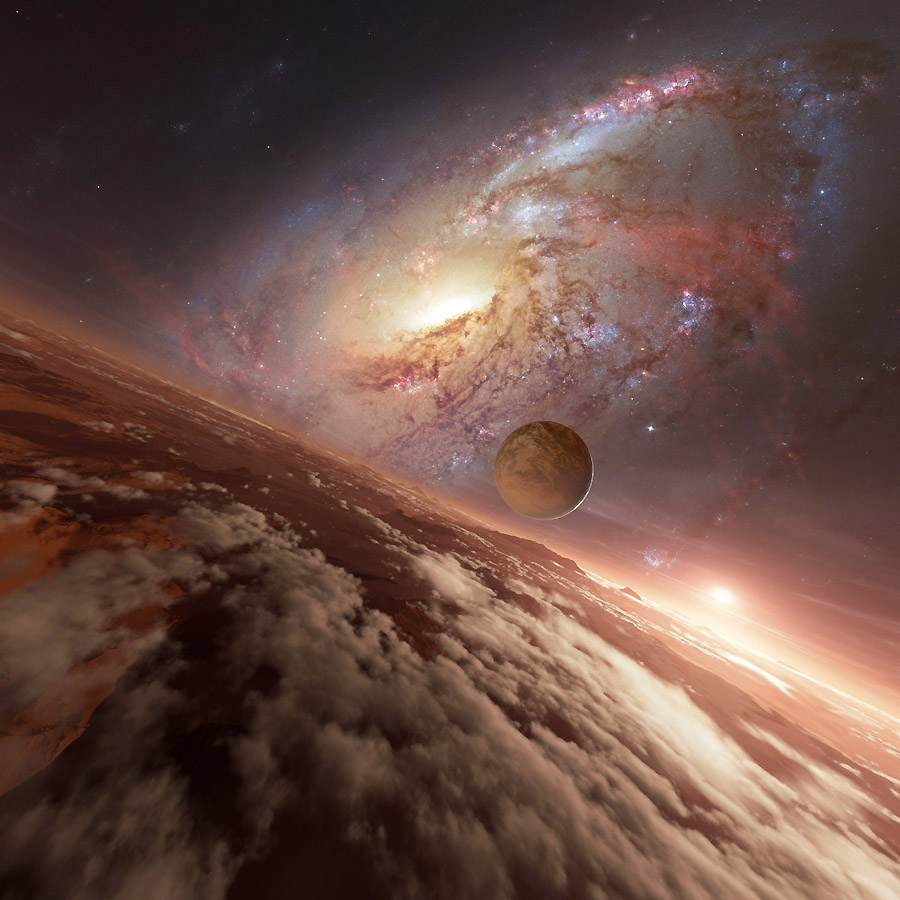

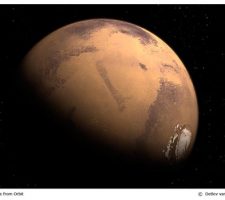

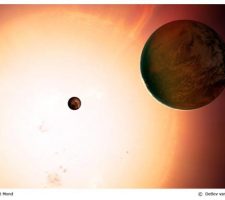
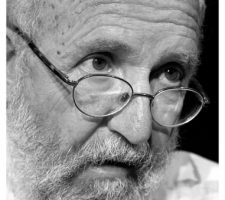
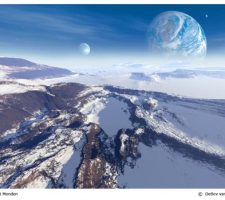

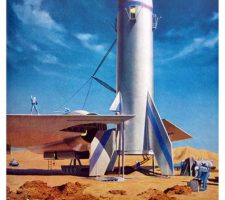

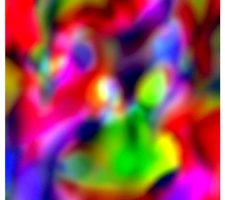
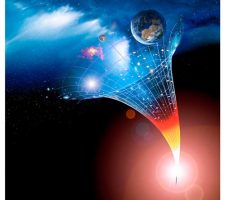
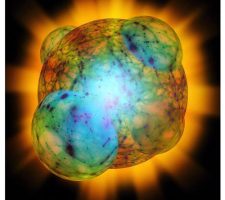
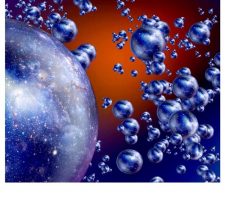




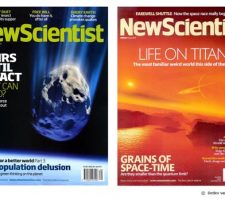
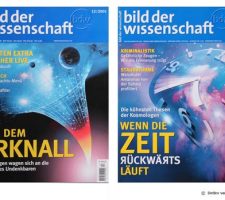
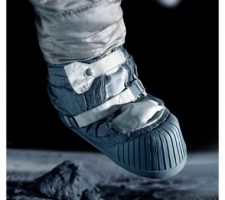
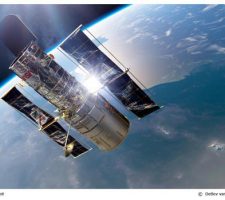
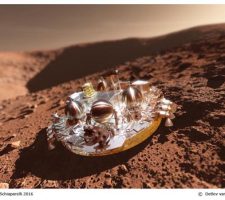
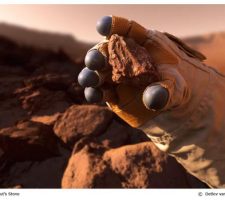
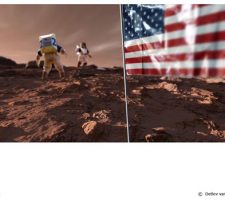
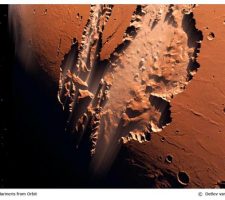
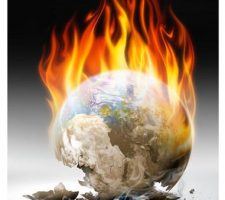


Be First to Comment